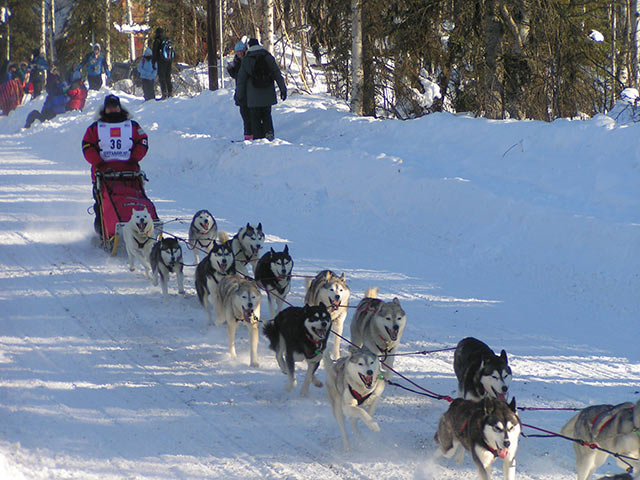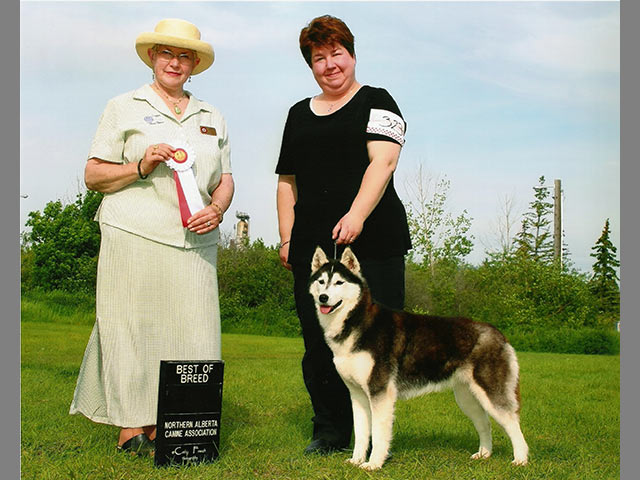Arctic Winds, Blue Ribbons


Five days later, Ramstead enters the show ring with one of those Siberians, brushed and cleaned up from sledding, trying to catch the judge's eye. The competition is fierce, and no amount of practice can assure that Ramstead and her dog will win.
There is an iconic image of an Iditarod musher – rugged outdoorsman, snow stuck to his grizzly beard. Asked about this, Ramstead laughs: "I'm a city girl through and through, raised in Toronto. I never even camped!"
How did this city girl end up racing the Iditarod? Unsure herself, Ramstead says it might have begun when she was a child in the 1970s. "My dad would tape the Iditarod on Wide World of Sports. That planted the seeds."
Ramstead knew nothing about sledding when she got her first dog, a Sheltie mix, in 1989. He had a great personality and did well in obedience. She wanted to compete in the show ring. Being a naive 19-year-old, Ramstead was shocked to learn this was impossible with a mixed-breed.
Ramstead decided she would find a pure-bred dog to compete with. "I liked northern breeds. This was in March, and I saw Iditarod scenes on television. Maybe it was subconscious, but I narrowed it down to Siberian Huskies or Malamutes."
She spent time reading about the two breeds. One day, she read a passage in a Siberian Husky book describing how they like sledding. Her mind became fixed on the idea.
The next chapter in Ramstead's life is a mix of determination and good fortune. She was spending a few days with a friend in British Columbia. One evening, her friend mentioned a Siberian Husky acquaintance. Ramstead recalls the scene. "I shouted, 'You're kidding! I'm looking for a Siberian.' We went to see these dogs."
It got better by the hour. The Siberians were sledders. A sled was available. There were snowy conditions. "The moment I stood on those runners, I knew this was going to be big. I had absolutely no plans to race the Iditarod. I just wanted to get behind a dog team."
Ramstead got her first Siberian from that kennel, a two-year-old female named Libby. In her mid-twenties, with her first pure-bred dog, full of excitement about racing, Ramstead hit the trails. It all seemed so natural. "In 1994, a friend told me about a 64-mile race in British Columbia. I tried it and won. The next year, there was a 120-mile race. Well, 64 was fun, so I figured 120 must be even better."
Soon, Ramstead had a kennel, North Wapiti, and a racing team. In 1996, she pushed her dogs to the next level. "We entered the 300-mile 'Race To the Sky' in Montana. We finished 4th. That was so much fun, I looked for a 500-mile race."
That year Ramstead also took her first best-in-show, with her Siberian Breezy. In the years that followed, Ramstead handled Breezy for numerous best-in-shows, and 30 group placements, all while training for big races.
After a banner year on the trail, and in the show ring, Ramstead had her first negative experience during a 500-mile race. "We were doing a marathon in Minnesota. My dogs were scratched after just 120 miles. It was so discouraging. But on that ride home, I decided I wanted to race the Iditarod. My husband turned to me and said, 'The level you want to get to requires a lot more dedication.'"
Starting in spring 1997, Ramstead became a full-time sledding trainer. In 1999, not quite ready for the Iditarod, she had another lucky opportunity. "A friend of mine knew someone racing the Iditarod. She had a plane and asked me to come along for a view from above, 'so I could see what I'm getting myself into.' I saw the trail, and how mushers worked with each other."
Everything Ramstead saw increased her excitement.
The next year, in 2000, Ramstead stood in a previously unimaginable position: on the runners of a sled at the starting gate of the Iditarod. Unfortunately, that first year, her sled cracked and her inexperience showed. After 900 miles, her team gave up. "My dogs lost faith in me. Still, 900 miles was quite an achievement. Since then, I've learned how to show my dogs that I'll look after them. They think, 'this seems crazy, but mom says it's OK, so let's keep going.' They trust there's a goal in site." Ramstead says this same kind of trust has helped her win in the show ring.
From 2000 to the present (except 2002), Ramstead and her Siberians have finished every Iditarod. She has also impressed a growing number of judges, owner handling her way to a long list of best in shows with the same dogs who finished Iditarods. In 2007, Ramstead went to the US Nationals and won the open-dog class with Crunchie, a three-time Iditarod finisher.
Fully committed to the dual worlds of the show ring and race trail, Ramstead unites the two as closely as possible. "I won't walk into the ring with dogs that haven't finished at least a 200-mile race. I've had dogs finish championships a few weeks after an Iditarod. It's nice bringing them into the ring with that muscle tone on! I've never believed in divisions between showing and racing. Being in the show ring with a great dog is teamwork, a thrill, the same bond as sledding."
Ramstead's current lead dog, Kara, has competed in the ring with her muscle tone on, and done quite well. "She's the first female Siberian to be a show champion and an Iditarod finisher."
Now that Ramstead has completed several Iditarods, she has another lofty goal, one for more climate-controlled conditions. "I believe in this style of dog and want more people to know Siberians' attitude and drive. Next, I'd dearly love to bring an Iditarod finisher to Westminster."
